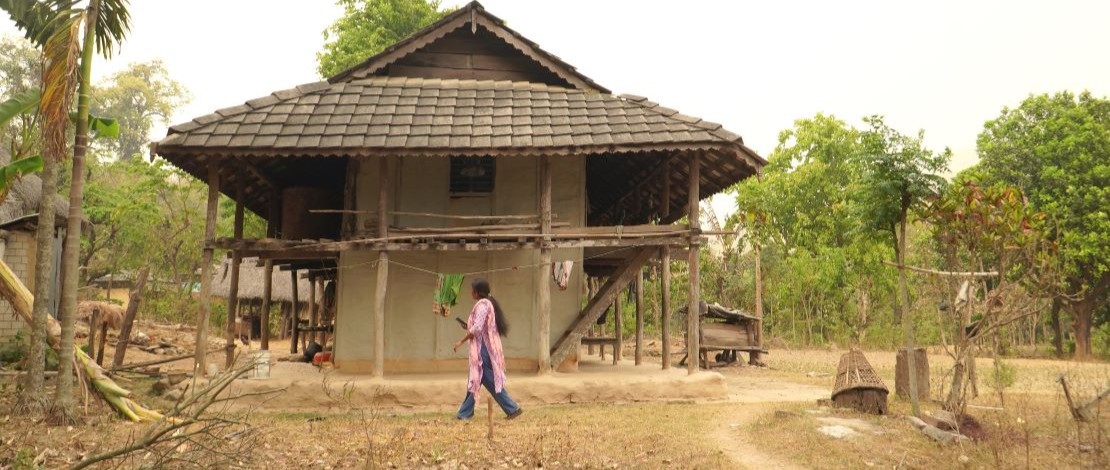Calming the waters with climate action
Riverbank restoration builds resilience in Nepal

Lalita Dhimal and her family of four live near the Telikhola River in Nepal, which used to flood her home and land during the monsoon season. But now, the riverbanks have been stabilized thanks to an ambitious climate project.
©FAO/Nepal
Lalita Dhimal and her family of four live on the banks of the Telikhola River, which flows through a populated area, called Urlabari, in Nepal’s Churia Hills at the southern edge of the Himalayas. Every year, heavy rains brought on by the summer monsoon season cause devastating floods in this area. The rapid waters of the overflowing river destroy farmland and homes, ruining lives and livelihoods.
“When we first came to this place, the settlement was very small and the river was very destructive," said Dhimal. "The torrents filled with stones, rocks, and uprooted trees ruined our crops.”
 Lalita Dhimal at her home. © FAO/ Nepal
Lalita Dhimal at her home. © FAO/ Nepal
Unpredictable rainfall, extreme weather events, and other climate change-related hazards pose an additional threat to vulnerable communities living around the forested river ecosystem.
But stabilizing riverbanks offers a life-saving solution.
Using bioengineering technologies, the Food and Agriculture Organization of the United Nations (FAO) and the Government of Nepal have helped communities build over 150 riverbank stabilization structures that enhance resilience to flooding.
These efforts are part of the Building a Resilient Churia Region in Nepal (BRCRN) project, jointly implemented by FAO and Nepal’s Ministry of Forests and Environment, with the support of the Green Climate Fund (GCF), which promotes climate-resilient land-use practices for more resilient ecosystems and communities.
"We use locally available materials like soil and mud to build these embankments. These methods are also known to be less expensive," explained Raj Kumar Gupta, Coordinator of the Provincial Project Management Unit. Carefully placed rocks and stones also create a protective barrier on the slopes of riverbanks, while grass turfing helps blend the structure into the environment.
Safe passage for elephants
Stabilizing the Telikhola’s riverbanks has also helped reduce human-wildlife conflict by preventing elephants from entering human settlements. The Telikhola River lies on the migratory route of elephants who often travel through the forests of southern Nepal and adjacent forests in India.
"In the past, elephants used to come right up to our house. We could do nothing but beat drums in the hope of scaring them away," said Dhimal. "But ever since the embankment was constructed, the elephants have not been able to cross over into human settlements."
For Dhimal and her family, the heavy rains are no longer a harbinger of destruction. “Now, when the river swells during the monsoon, it doesn’t enter the settlement,” she says with confidence. "We don't have such problems anymore, the embankment has benefitted us."
Protecting homes and harvests
The embankments have played a vital role in protecting homes, farmland, and livelihoods in nearby towns, such as Janabasti. Here, mostly poor farmers who planted rice and maize on the riverbanks as sustenance for the entire year were usually forced to watch helplessly as the river flooded crops on the brink of harvest every year.
"This year, thanks to the embankment, the river flowed along its course, and the farmers were able to harvest their crops and enjoy the fruits of their labour," said Rajan Kumar Kandel, Chair of Ward 2, in the Urlabari municipality. He noted that the farmers "were grateful."

A villager's house is now safe from flooding thanks to the project's riverbank stabilization works. © FAO/ Nepal
In another town, called Sisneri Thapa Khahare, the river’s raging waters after heavy rains would displace residents. "When the river rose in monsoon, we didn't sleep. We kept a watch on the bank with torchlights on, ready to run at any moment," explained Prem Bahadur Thokar, Chair of Embankment Building Committee in Sisneri Thapa Khahare.
But displaced families started going back to their homes when they saw the protective benefits of natural embankments. "These days we are able to sleep through monsoon rains," said Thokar.
From upstream to downstream
These structures also protect lands further downstream. "My house is in imminent danger every time the river floods. But what is not so apparent is that the floods can turn hundreds of acres of adjacent land barren," said Moti Prasad Phuyal, a villager from Dhobikhola. But once the riverbanks had been stabilized as part of the BRCRN project, he noticed that his house and farmland were better protected.

Carefully placed rocks and stones create a protective barrier on the slopes of riverbanks. © FAO/ Nepal
Conservation efforts upstream have a huge positive impact downstream. Stabilizing riverbank structures has not only protected lives and livelihoods, but also helped conserve soil, water, and surrounding ecosystems, helping humans live in harmony with nature.
In total, 168 embankments now protect over 7,500 hectares of farmland, benefiting more than 83,000 people.


